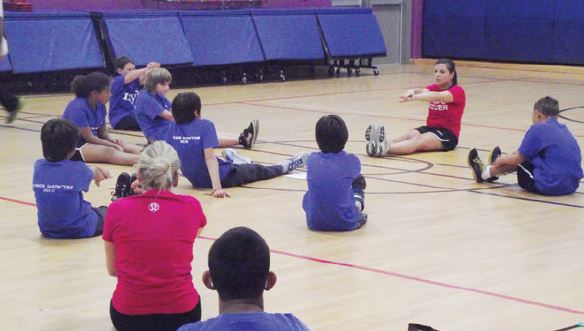At Star Academy, gym class is about more than just running around.
 Think back to your elementary school days: do you remember gym class? Maybe you loved it and were always active. Or maybe you were on the bench waiting for it to end, or hoping you weren’t the last one picked. At Star Academy, those distinctions don’t exist: they’ve got a whole new approach to physical education.
Think back to your elementary school days: do you remember gym class? Maybe you loved it and were always active. Or maybe you were on the bench waiting for it to end, or hoping you weren’t the last one picked. At Star Academy, those distinctions don’t exist: they’ve got a whole new approach to physical education.
“We talk about ‘physical’ in terms of physical literacy,” says Principal Belinda Bernardo. “We’re looking for coordination, balance, speed, endurance and agility: these are key components to our gym program, and they’re all woven around fun activities. We’re not interested in scores—we want students to see games and exercise as functional and fun.”
Much research has been published showing the connection between exercise, brain function and academic skill. A 2012 study from the University of Louisiana concluded that physically fit students scored 16–19 points higher on standardized tests than unfit students, and a 2011 study published in the Journal of School Health from Stanford University found disparities in both math and English scores between fit and unfit students.
Every child at Star Academy gets 40 minutes of daily phys-ed. As a result of this gym program, the school has observed a 39 percent improvement in combined physical abilities, a 14 percent improvement in executive functions and a 30 percent improvement in focus. “Physical activity promotes the growth of neurons and blood cells within the brain, which improves learning and memory,” says Bernardo. “It’s why children should exercise before taking really important tests or exams.”
Fitness Fun
“We have dedicated phys-ed teachers here,” says teacher Kelly Farrell. “It makes a big difference compared to a general teacher who might be unfamiliar with developmental milestones. For example, station activities in gym class include cognitively oriented tasks and promote transferable skills, so there’s a lot more going on than just an enjoyable game.”
So does that mean that the kids don’t play any competitive sports? “Competition is key,” says Bernardo, “but we don’t need to keep score. The focus is on developing the skill sets that can be applied to any sport going into high school—it would be negligent if we didn’t teach that—but it has to be fun. Win or lose, they enjoy and learn from their experiences.”
Not Just Exercise
Of course, what’s an innovative phys-ed program without a nutritional component to complement it? Star Academy also has a vegetable garden which students help tend. This year, they’re growing raspberries, peppers, cucumbers, tomatoes, squash and kale, and through this, students gain a cyclical understanding of where everything comes from.
“They love it,” says Bernardo. “One year, the Grade 7s and 8s wanted to sell the produce, as a math project. They calculated how many they hours put in, how much it cost to put it together, and how much the produce sold for, to see if it was worth it. It’s real-world math.”
“For Thanksgiving, we do a harvest and have a big Thanksgiving feast,” adds Vice Principal Pam Rennie. “Every class participates in making a portion of the meal, and we take a trip to a farm for the rest of the produce. If there are any leftovers, we take it to a local hot kitchen. The kids understand that we don’t waste, and that there are people in need within our own community.”
This combined approach shows students that physical activity and nutrition are just as important to academic success as hitting the books. Says Bernardo: “We want to show the children that everyone needs to be physical: it’s better for your brain, for your body and for a healthy, long life.”
 1587 Cormack Crescent
1587 Cormack Crescent
905-891-1555
staracademy.ca
(Originally posted on mississaugalife.ca. The print version originally appeared in Spirit of the City/Mississauga Life, issue 20, 2013; the PDF of that is available here.)

